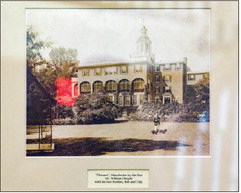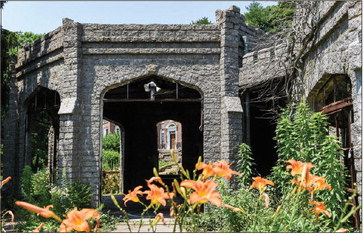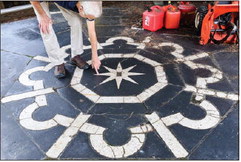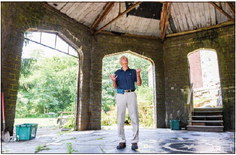from the Gloucester Daily Times, July 16, 2021
Town, school exploring options for Gilded Age house
By Julie Manganis Staff Writer
MANCHESTER — There are still traces of grandeur in the decaying stone structure at the edge of what was once a Gilded Age “cottage” known as Elsinaes.
The garden or tea house, at the corner of the property near the intersection of Bridge Street and Highland Avenue in Manchester, was made of Rockport granite and steel, with an elabor at e t i l e floor and large soapstone fireplace. It likely had large areas of glass roof.
“It was quite the place,” Landmark School facilities director Dave Seiter said.
In its time, Elsinaes, and the stone tea house, had been the home of railroad heiress and socialite Alice “Elsie” Forbes Perkins Hooper. It was one of many expansive properties in Manchester and Beverly along the ocean, an area dubbed “The Gold Coast.”
Hooper counted among her friends the historian Frederick Turner, fellow arts patron Isabella Stewart Gardner, and author Willa Cather, who is believed to have based characters in one of her books on Hooper’s parents. President William Howard Taft had been reported to be a guest.
“It’s a solid, impressive structure with a lot of history to it,” Seiter said.
But it has also fallen into dangerous disrepair, its steel beams starting to fail. Seiter had to take down spires that were in danger of falling. Pieces of stone have come loose. Seiter had sealed off missing windows and doors.
“I’ve basically tried to keep it safe,” he said.
But recently, Seiter had made the difficult decision to demolish the structure. A crew was scheduled to arrive earlier this week.
Then, last Thursday, he got a call from an assistant headmaster, who in turn had heard from the town’s planner, Sue Brown.
For the first time he was told that there was a chance that community preservation funds might be available.
“I thought, ‘This is like a dream come true,’” Seiter said. “Let’s do it.”
But there’s a problem: the property isn’t public. It has been used to store the belongings of the school employees who live in the main house. In order for community preservation funds to be used, the restoration would have to serve a public purpose. And no one is sure what that would look like.
After touring the site with the chair of the town’s historic commission Tuesday, his hopes dimmed.
“It’s going to cost an awful lot of money to restore,” Seiter said. It’s money the school cannot afford.
Beyond that, the latest maps now put the garden house in a flood zone.
According to historical accounts, the house was built in 1899 for Elsie Hooper. She was the daughter of Charles Elliott Perkins, who was president of the Burlington Railroad, and Edith Forbes Perkins, whose family had made its fortune in the Chinese and opium trade. Elsie was already in her late 20s by the time she married widower and financier William Hooper in 1895.
While she never had children, and by her 40s often relied on crutches to walk, Hooper remained an active host and also wrote numerous letters to friends. She became a major benefactor to Turner while he was at Harvard in the early part of the 20th century. (Turner’s work has been criticized for ignoring the role of slavery and exploitation of others in the country’s western expansion).
She later put together a collection of her own memories of the place, including the garden house.
After Hooper’s death, the home went to William Youngman, who had married her niece. It remained in the family until 1972, when Landmark acquired it. Seiter knows there’s history in the property, though the small structure does not appear on any historic registers.
Brown said she is also hoping to find a way to save the structure.
Any final plan would first require a study to evaluate its existing condition, at a cost of up to $20,000, said Brown.
“Someone has to say we really want to save this before we spend that kind of money,” Brown said.
Seiter also heard this week from a company that proposed dismantling the remaining structure and carting it off to a vineyard in Virginia to be re-assembled there. The idea would both save the structure and help the school make some money. He told the caller he’d let him know but wants to give the town a chance to come up with a plan first.
Courts reporter Julie Manganis can be reached at 978-338-2521, jmanganis@ gloucestertimes. com or on Twitter at @
SNJulieManganis.




Image 1
Landmark School facilities director Dave Seiter stands in what remains of a historic tea house on the school’s Manchester property, on the edge of what was once a Gilded Age cottage known as Elsinaes. The tea house has fallen into disrepair and its fate is uncertain.
JAIME CAMPOS/Staff photo
Image 2
A photo of Elsinaes at Landmark School. William Hooper stands in the foreground with his Scottish terriers, Bob and Tilly.
Image 3
The stone tea house on the ground of Lanmark School’s Manchester property was made of Rockport granite and steel, with an elaborate tile floor and large soapstone fireplace. But in recent years, steel beams have started to fail and pieces of stone have come loose.
JAIME CAMPOS/Staff photos
Image 4
Landmark School Facilities Director Dave Seiter points to the elaborate tile work on the floor of what was once a tea house, the remains of which are used for storage on the private school’s Manchester property. Seiter said flooding has damaged the floor and affected the building’s structural integrity.